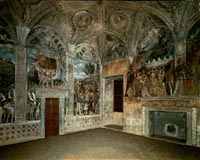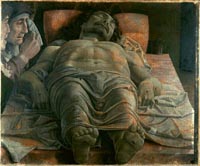Andrea Mantegna was born in Isola of Carturo at the end of 1430 or the beginning of 1431. He moved to Padua at the age of ten and started working in the workshop of Francesco Squarcione. Artists like Paul Uccello, Filippo Lippi and Donatello were working in this city at the time and it was a very stimulating work environment for a young artist like Mantegna.
In 1448 he was asked to join a team of artists decorating the Ovetari chapel in the chiesa degli Eremitani in Padua. He painted Stories of St James and St Christopher but the only part of the frescoes to survive is the Apostles, the Assunta from the apse and the two stories of the Martyrdom of St Christopher and the Transport of the saint’s body, which were transferred elsewhere because of the poor condition they were in. The frescos left in place were destroyed during World War II. These works show the elements of Mantegna’s style: drawings are sharp and people’s figures slightly angular which makes them clearly defined against the background. Perspective is used to make scenes and people monumental. In the Martyrdom of St Christopher and in the Transport of the Saint’s body colours are softer and less harsh, probably because the artist was influenced by the works of Gentile and Giovanni Bellini (which were softer and more gentle than his own). An example is oration in the garden in the London National Gallery.
 Shortly after the work above he painted the Polyptich of St Luke (Brera National Gallery) and Sant'Eufemia (Gallery of Capodimonte, Naples).
Shortly after the work above he painted the Polyptich of St Luke (Brera National Gallery) and Sant'Eufemia (Gallery of Capodimonte, Naples).
In 1457 he received a commission for the Polyptich of St Zeno in the churchdel St Zeno in Verona. It is one of his masterpieces. The main scenes - a holy conversation – take place in a classical ‘quadriportico’ (an open space surrounded by porticoes on all sides); episodes of the passion of Christ (including the Crucifixion) were painted on the predellas and are today in the Louvre and the museum of Tours.
In 1460 Ludovico Gonzaga invited him to his court in Mantua where he became the court’s artist. He decorated the Wedding Chamber in palazzo ducale. The chamber’s large pictures should all be viewed from the centre of the room. The light in the pictures comes from the same direction the light enters the room. In some scenes the people of the Gonzaga court and some of the episodes of life in the court are faithfully depicted; one of them is the meeting between Ludovico Gonzaga and his son, a newly elected cardinal. In the vault Mantegna painted the famous round oculum showing the sky; animals and plants are painted round it. The frescos for the wedding chamber were probably finished in 1474.
During these years in the court he painted many portraits and a chapel in the castle of St Giorgio (nothing survived).
He painted a number of small plates which were supposed to be connected but have since then been divided between many museums. The plates include Death of the Virgin (Prado Museum of Madrid) and the so called Tryptich of the Uffizi which includes t he Adoration of the Magi.
he Adoration of the Magi.
Other famous paintings from this period are dead Christ of Brera (famous for the rather daring view) and St Sebastian (Louvre museum).
In 1485 he started the first of a series of great canvases painted with tempera with the Triumph of Caesar; he had to stop working on this project when he was invited to Rome by Innocent VIII who commissioned the paintings in a chapel in the Vatican Halls (the chapel was destroyed in 1780).
At the end of the XV century Mantegna was in Mantua where he painted Madonna of Victory, commissioned by Francesco Gonzaga to celebrate his victory in the battle of Fornovo in 1495; in 1497 the artist painted Madonna of Trivulzio in the church of Santa Maria in Organo in Verona.
He painted two canvases for the study of Isabella d'Este with mythological characters: Parnasus and Minerva banning vice; he died on 13th September 1506 before he could finish a third canvas, the Fable of the god Como.
Vasari, Le vite de' piu eccellenti pittori scultori et architetti
Ebbe sempre opinione Andrea, che le buone statue antico fussino più perfette e avessino più belle parti, che non mostra il naturale; attesochè quegli eccellenti maestri, secondo che è giudicava e gli pareva vedere in quelle statue, evevano da molte persone vive cavato tutta la perfezione della natura, la quale di rado in un corpo solo accozza ed accompagna insieme tutta la bellezza. Onde è necessario pigniarne da uno una parte e da un'altro un'altra: ed oltre a questo, gli parevano le statue più terminate e più tocche in su muscoli, vene, nervi ed altre particelle, le quali in naturale, coprendo con la tenerezza e morbidezza della carne certe crudezze, mostra talvolta nemo...
E si conosce di questa opinione essersi molto compiaciuto nell'opere sue; nelle quali si vede invero la maniera un pochetto tagliente, e che tira talvolta più alla pietra che alla carne viva
Lanzi, Storia pittoria dell'Italia
Ogni testa ( nella Madonna della Vittoria) puo servire di scuola per la vivacità e pel il carattere, e alcune anco per l'imitazione dell'antico; il disegno tutto, si ne nudo, si nel vestito, ha una pastosità che smentisce l'opinione più comune. che stil mantegnesco e stil secco sieno una stessa cosa. Vi è poi un'impasto di colore, una finezza di pennello, e una grazia sua propria, che a me pare sia l'ultimo passo dell'arte priam di giungere alla perfezione che acquistò Leonardo.